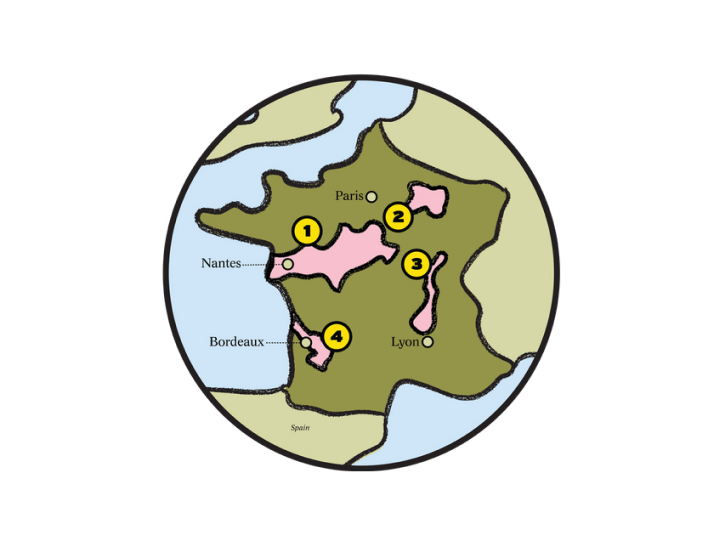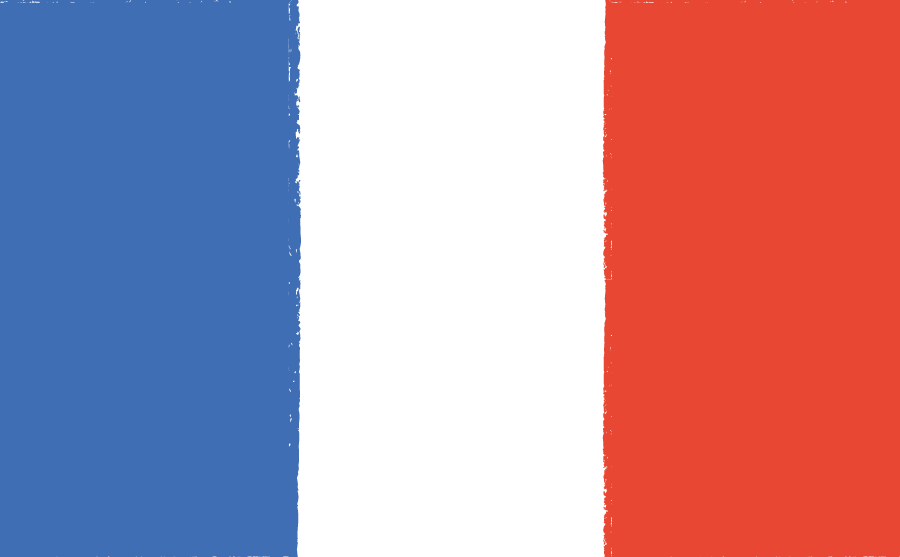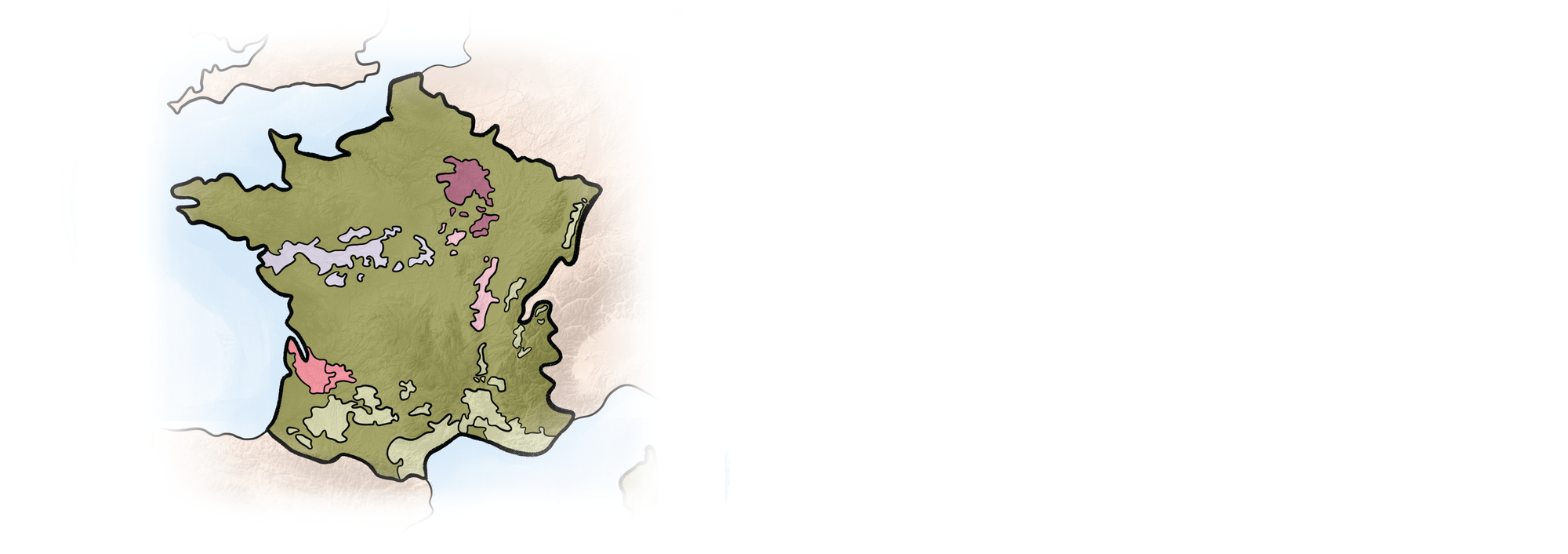

Widely considered to be the spiritual home of wine. Big names, bigger pricetags, but plenty of great wine.
History--red
France is kind of a big deal in the world of wine. Along with all of northern Europe, much of France’s wine industry was nearly decimated in the nineteenth century due to the vine louse, phylloxera. When it was discovered that American root stock was immune to the bug, vineyards in Burgundy, Bordeaux and Champagne were grafted over and recovered rapidly.

In 1855 Emperor Napoleon III requested a classification system be developed to identify Bordeaux’s best wines. The so-called first through fifth "growths" or crus was a highly subjective designation but is still in place today with only a few small changes. On top of this system, the AOC or appellation d’origine côntrollee, is based on the idea that food and wine products that come from a specific place need to have protections to ensure quality and prevent fraud. The French adopted this system in the 1930s.

Top French wines command some of the highest prices in the world today from collectors with deep pockets, but it no longer holds the same level of power in the market it once did due to intense global competition and slowing level of wine consumption within its borders. But wherever you go in France, rest assured that a fabulous meal and equally wonderful wine are waiting to be enjoyed.
Main regions--earth
Loire Valley - The Loire Valley (which follows the Loire River) runs east-west across the centre of France, reaching the Atlantic Ocean. Split into four main parts, there are world-class Chenin Blanc, Cabernet Franc and Sauvignon Blanc made here. On the coast of the region, they produce fresh and clean white wine from the Muscadet grape (not related to Muscat or Moscato!). It's famed for its more neutral flavours, high acidity, and creamy texture from time on the lees. No matter the grape, you can expect wines from this region to be cool, elegant and hold plenty of acidity.
Champagne - the very fact that Champagne has become a genericised trademark (in the same way as Hoover or Band-Aid) should tell you how popular this fizz is. The gold standard for sparkling wine around the world. So famous (and so commercially successful) that the local winemaking committee lobbied (successfully) for the geographical area to be increased!
Burgundy - this moderately sized region in the east of France is home to some of the most iconic wines in the world. Planted to Chardonnay and Pinot almost exclusively, the vineyards are separated into two distinct regions, north and south. Within these regions, there are innumerable subregions, villages and vineyards, each of which offers wines of a slightly different character. The southern area of Burgundy (moving toward Lyon) is the Beaujolais region, which has built a reputation for its red wines using the Gamay grape.
Bordeaux - the home of great Cabernet Sauvignon and Merlot, some of the world's longest-lived reds. Also, you will find the great dessert wines of Sauternes, made from botrytis affected Sauvignon Blanc and Semillon. Famous names like Rothschild, Latour and d'Yquem are found here, ensconced in a huge chateau.

Cheat Sheet to French Wine Labels--racy
Red Burgundy - If someone ever tells you they are drinking "Red Burgundy" it means they are drinking Pinot Noir from the Burgundy region. This is cult-favourite Pinot and arguably some of the best and most classic expressions of this red grape in the world. And the most expensive.
White Burgundy - When it comes to white wines, Chardonnay is supreme in Burgundy. So "White Burgundy" is simply Chardonnay from the Burgundy region. Creamy, richly textured and with a generous (but very sophisticated) dallop of French Oak. White Burgundy is a benchmark expression of Chardonnay that the rest of the world consistently tries to emulate.
Chablis - In the most northern reaches of the Burgundy region — quite close to Champagne in fact — is the cool and continental region of Chablis. The wines of this tiny region are predominantly Chardonnay, but not your usual oak forward and weighty style. Instead these wines and made in a clean crisp style with plenty of zip and citrusy zing, and without a noticeable influence of oak. So if you find you don't typically like Chardonnay, this style might offer a new glimpse of what this grape is truly capable of!
Red Bordeaux - This is the famous blend, involving Cabernet Sauvignon, Merlot and a few other friends to a lesser extent like Cabernet Franc, Petit Verdot, and Malbec. These are powerful, long-lived styles that are more savoury than their New World counterparts.
White Bordeaux - Thanks to the high acidity of this blend, Sauvignon Blanc & Semillon blends make for some of the most ageable white wines on the market!
Sauternes - Sauvignon Blanc & Semillon also come together to play a part in making world-famous sweet wines in the Graves region of Bordeaux. These delicious wines are known for their intensely concentrated flavours of honey, apricot, marmalade, ginger and sweet citrus.

Sancerre - This is a small sub-region in the Loire Valley known for making flinty, mineral-driven Sauvignon Blanc. However, once in a while you may also come across a red "Sancerre" which is typically Pinot Noir! Both of which pair beautifully with local Chèvre (goats' cheese).
Pouilly Fumé - This is another subregion of the Loire Valley known for Sauvignon Blanc. However here, the savvy spends time in oak making for a fuller-bodied and richer expression of the grape.
Champagne - there are actually 6 allowable grape varieties in Champagne, but the main trio is Pinot Noir, Chardonnay and Pinot Meunier.
Blanc de Blancs - This directly translates to "White of the Whites" meaning, the white juicy of white grapes! You'll often see Blanc de Blancs on sparkling wines labels. It simply means only white grapes were used. In Champagne, Blanc de Blancs is famously dominated by Chardonnay (thought other local white grapes are permitted) and are known for making wines with lacy texture, citrus flavours and bright acidity.
Specific wine styles--aromatic
Each of the regions above are world benchmarks in their own right! Plus Rhone Valley Shiraz & Grenache, Provence Rosé, Alsace Riesling... the list goes on. France is number one in wine for a reason.
Do you know your wine personality? If your answer is no, take our quiz to find out which wines to pick up next and build your box!
Build my box





